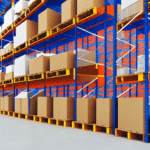Optimizing Production Logistics for Maximum Efficiency
In today's fast-paced business landscape, optimizing production logistics is critical to achieving maximum efficiency. Organizations need to have seamless processes in place to ensure a smooth flow of goods and materials from the point of origin to the point of consumption. This includes managing everything from transportation and inventory management to warehousing and order fulfillment.
Understanding the Importance of Production Logistics in Today's Business Landscape
Production logistics refers to the planning and coordination of all activities involved in the movement of products and materials within a manufacturing facility, as well as between different facilities. It plays a vital role in ensuring that businesses are able to meet customer demands while keeping costs under control. By optimizing production logistics, organizations can minimize transportation and storage costs, reduce downtime, increase throughput, and improve the overall efficiency of their operations. According to a McKinsey report, companies that excel in logistics can achieve up to 20% cost savings.
Moreover, production logistics helps businesses maintain quality control and ensure timely delivery of products to customers. With the help of advanced technologies such as automation, artificial intelligence, and data analytics, production logistics can be further optimized to achieve greater efficiency and cost savings. Therefore, it is essential for businesses to invest in production logistics and continuously improve their processes to stay ahead of the competition.
The Role of Technology in Streamlining Production Logistics
Technology has played a significant role in streamlining production logistics. Today's organizations can use advanced tools and software to help them automate and optimize their logistics processes. These technologies include warehouse management systems, transportation management systems, and RFID technology, among others.
By leveraging these technologies, organizations can improve the accuracy of their inventory management systems, reduce shipping times, and track shipments in real-time. According to a Supply Chain Digital report, companies that implement advanced logistics technologies can see a productivity increase of up to 25%.
In addition, technology has enabled organizations to better manage their supply chain networks. With the help of advanced analytics and data visualization tools, organizations can gain insights into their supply chain operations and identify areas for improvement. This can include optimizing transportation routes, reducing inventory costs, and improving supplier relationships. By leveraging technology to streamline their supply chain networks, organizations can enhance their overall competitiveness and better meet the needs of their customers.
Key Challenges of Managing Production Logistics and How to Overcome Them
Managing production logistics can be a complex and challenging task. One of the key challenges is managing inventory levels effectively. Organizations need to maintain a delicate balance between having enough inventory to meet customer demand and avoiding overstocking, which can lead to higher storage costs.
Another challenge is managing transportation costs. Transportation costs can vary greatly depending on the mode of transportation and distance. However, by implementing more efficient transportation methods and optimizing routes, businesses can significantly reduce these costs. For instance, optimizing delivery routes using GPS and real-time traffic data can lower fuel consumption and improve delivery times.
Finally, managing order fulfillment is crucial. Businesses need to ensure that orders are fulfilled in a timely and accurate manner. Utilizing automated order fulfillment systems can significantly improve the speed and accuracy of these operations, leading to higher customer satisfaction rates.
In addition to these challenges, ensuring product quality and managing the supply chain effectively are also critical. Quality control measures must be implemented throughout the production process, from raw materials to finished products. Furthermore, coordinating with suppliers, manufacturers, and distributors ensures that materials and products are delivered on time and in the right quantities. Effective supply chain management strategies can reduce lead times, improve inventory management, and increase overall efficiency.
Best Practices for Planning and Scheduling Production Logistics Operations
Effective planning and scheduling are critical when it comes to optimizing production logistics. The following best practices can help businesses achieve maximum efficiency:
- Implement a robust inventory management system to track inventory levels in real-time and minimize stockouts.
- Use data analytics to forecast demand and optimize production schedules.
- Apply lean manufacturing principles to eliminate waste and improve production efficiency.
- Establish clear communication channels between different departments involved in production logistics.
- Maintain flexible production schedules that can adapt to changing demand and supply conditions.
Another important best practice is to prioritize safety. This includes ensuring that all equipment is properly maintained and that employees are trained on safety procedures. By prioritizing safety, businesses can avoid costly accidents and downtime.
Regularly reviewing and analyzing production logistics processes to identify areas for improvement is also essential. This can involve conducting regular audits, gathering feedback from employees, and benchmarking against industry standards. By continuously improving processes, businesses can stay ahead of the competition and achieve long-term success.
Strategies for Reducing Costs and Boosting Efficiency in Production Logistics
Reducing costs and boosting efficiency in production logistics requires a holistic approach. Here are some strategies that businesses can use:
- Implement automation to reduce manual labor and improve accuracy.
- Use advanced analytics to identify inefficiencies and optimize processes.
- Embrace the use of technology to streamline logistics operations.
- Implement a continuous improvement program to ensure that production logistics processes are constantly being optimized.
- Maintain a culture of collaboration and teamwork between different departments involved in production logistics.
Optimizing inventory management is another key strategy. Implementing a just-in-time (JIT) inventory system ensures that materials and supplies are delivered to the production line exactly when they are needed. This reduces the need for excess inventory, which can tie up capital and increase storage costs.
Additionally, businesses can consider outsourcing certain aspects of their production logistics to third-party logistics providers (3PLs). This can help reduce costs by leveraging the 3PL's expertise and economies of scale, while also allowing the business to focus on its core competencies. It is important to carefully evaluate potential 3PL partners to ensure that they align with the business's needs and goals.
Harnessing Real-Time Data Analytics to Improve Production Logistics Performance
Real-time data analytics can provide valuable insights into production logistics performance. By monitoring key performance indicators in real-time, businesses can identify areas for improvement and make data-driven decisions. Some of the key performance indicators that businesses can track include inventory levels, throughput times, and transportation costs. Monitoring these metrics allows businesses to pinpoint inefficiencies and optimize their logistics processes accordingly.
In addition to these metrics, real-time data analytics can help businesses identify potential bottlenecks in their production processes. By analyzing data from various stages of production, businesses can address delays or inefficiencies promptly. Furthermore, real-time analytics can enhance supply chain management by tracking supplier performance, delivery times, and inventory levels. This ensures that businesses have the right materials and products available at the right time, reducing costs and improving customer satisfaction.
Case Studies: Success Stories of Companies that Optimized their Production Logistics for Maximum Efficiency
Several companies have successfully optimized their production logistics to achieve maximum efficiency. For example, BMW implemented a highly flexible logistics system that allows them to produce up to 36 different variants of a model on a single production line. This strategy has helped the company dramatically reduce lead times and inventory levels while also improving product quality.
Procter & Gamble is another success story, having implemented a real-time transportation management system to optimize its logistics operations. This initiative enabled the company to reduce transportation costs by more than 20% while improving delivery times and customer satisfaction.
Amazon has also revolutionized its logistics by implementing a highly automated and efficient system that allows for rapid delivery of products to customers. This has given Amazon a competitive edge in the e-commerce industry and significantly boosted customer satisfaction.
Toyota's implementation of a lean production system, which focuses on reducing waste and improving efficiency, has led to reduced lead times, lower inventory levels, and decreased production costs. Additionally, this approach has enhanced product quality and customer satisfaction. By continuously improving their production logistics, these companies have maintained their competitive positions and achieved long-term success.
Future Trends and Innovations in Production Logistics Optimization
As technology continues to advance, further innovations in production logistics optimization are expected. The use of autonomous vehicles and drones could revolutionize transportation and warehousing, while artificial intelligence and machine learning can help businesses better forecast demand and optimize production schedules.
Another emerging trend is the application of blockchain technology in production logistics. Blockchain can provide a secure and transparent way to track products and materials throughout the supply chain, reducing the risk of fraud and errors. Additionally, blockchain enables more efficient and accurate tracking of inventory, helping businesses better manage stock levels and reduce waste. As blockchain technology matures, more businesses are likely to adopt it as a key tool in their production logistics optimization strategies.
Overall, the key to optimizing production logistics for maximum efficiency lies in embracing technology, implementing best practices, and maintaining a culture of continuous improvement. By staying informed about the latest trends and innovations, businesses can ensure they remain competitive and responsive to the ever-evolving market demands.




















